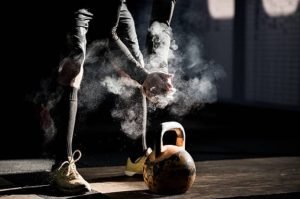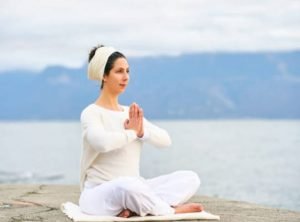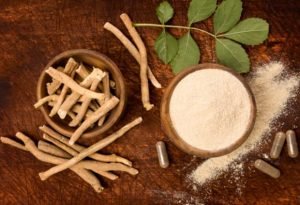
by admin | May 30, 2022 | General, Health
Spring Detox – Herbs For Detoxification
Spring a time for detox and herbs are one of the best ways to aid that detox and cleanse.
Herbal remedies are also seeing a rise in popularity once again. This includes using herbs for detoxification. Many people like the idea of using herbs as natural products have minimal side effects. Herbs in fact have many therapeutic abilities. The following list explains some western herbs commonly used for detoxification and why they work.
Dandelion

– This is an herb that is good for the whole body, specifically the immune system. It works to eliminate toxins from the cells in the body. It also increases bile and helps it move along. It is credited with boosting white blood cells thus strengthening the immune system.
Liquorice Root – This herb has properties that work like an antioxidant, fight viruses and helps the body produce antibodies.
Cascara Sagrada – This herb works like a laxative. It helps the bowels move.
Black Walnut Hulls – This herb also works in the bowels. It works against parasites and removes them from the intestines. It also helps remove fatty material and toxins.
Garlic – Garlic is the classic kitchen-pharmacy remedy and has been used for centuries as an antiseptic. It detoxifies the gut and helps the bowels function properly. It works like a laxative in making the bowels move regularly.
Goldenseal – this herb is well known for its cleansing power. It can rid the body of toxins and help to remove obstructions.
Psyllium – This herb also works to help move the bowels.
Here are some Chinese herbs that are used for detoxification.
Lian Qiao is the forsythia flower. It has a cleansing action and helps to clear heat and toxins.
Ju Hua Otherwise known as the Chrysanthemum. This is a pungent herb that should not be overcooked, or it will lose its potency. It has cleansing properties.
Pu Gong Ying

is the dandelion plant. It is the parts of the plant above the root that is being used as a remedy. It is effective as a detoxification herb. It is important to know that the main point of detoxification is removing toxins from the body, usually through the bowels. Using herbs is gentler on your system than other methods and you get additional benefits from the nutrients that herbs supply.
If in doubt always consult a herbalist or naturopath.

by admin | May 30, 2022 | Workouts
Squat 101 | Part 1 – Front vs Back Squat
Legs are a neglected muscle group by many for one reason – it requires a bigger effort to train them. However, legs form one half of our body and it is really important to train them for two reasons:
- Aesthetic physique isn’t possible without training legs
- It is good for our general health
The squat is undoubtedly one of the best compound movements to build strength in our legs and make them grow. It is part of the big 3, along with the bench press and the deadlift. Furthermore, it is used by novices, intermediaries, and advanced lifters to reach their goals. Yet, there are a couple of different variations of the traditional squat, and today we are delving deeper into them.
What Is The Difference Between Front and Back Squat?
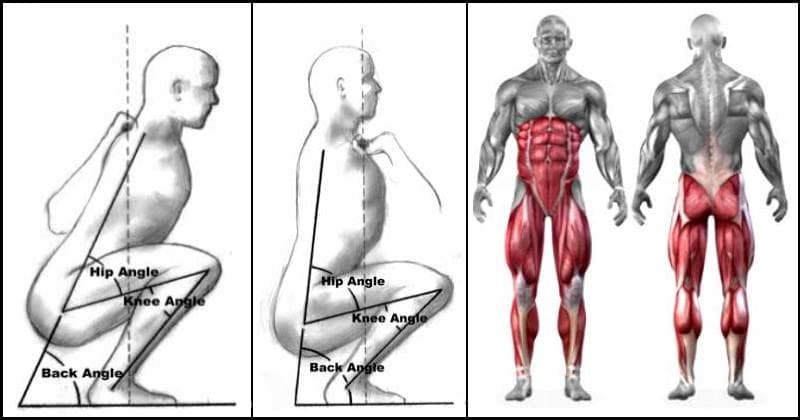
As we mentioned above, squats require a lot of effort and concentration. Whether you are doing a front or back squat you have to be prepared physically and mentally to get under the bar. The main differences between the two are in the position of the bar and the primary muscles targeted. By changing the position of the bar our torso also changes positions when performing each one of the squats.
The Front Squat targets the quadriceps, the adductors, the glutes, the core, and also the upper back (upper trapezius) of the trainee, however, your hamstrings are NOT significantly contributing to the movement. The exercises can be used as a primary leg movement OR it can be used as an assisting exercise.
The Back Squat on the other side puts our torso in a more horizontally position and allows a bigger range of motion. The Back Squat is splitted into High Bar and Low Bar Squat, which are analyzed in detail here. (insert link for the article) In general, the Back Squat targets the quadriceps, the hamstrings, the glutes, the lower back, the upper back.
In other words, the whole body is engaged when performing a back squat. Another thing to keep in mind is that the front squat puts less pressure on your lower back. The reason for this is because when performing a front squat we are leaning forward less, compared to the back squat. Now, that doesn’t mean the back squat is more dangerous for your lumbar spine. When executed perfectly, the back squat can only strengthen your lower back and it is the same for the front squat.
But you probably wonder…
Which One Is Better For Growing Your Legs?
There is no better exercise than others. In general, if you are looking for optimal strength and hypertrophy in your legs you should go with the back squat. The reasons for that are stated below:
- The Back Squat has a bigger range of motion, which means that there are more muscles activated
- You can progress on a weekly basis and get to more kgs on the bar, compared to the front squat
- When squatting heavy our core is activated more, which is a general benefit
However, that doesn’t mean you should totally exclude front squats from your training routine. Nevertheless, doing both will bring you nothing but welfare. You can implement some heavy back squats (intensity) and some light front squats (volume) for the best results. Your legs will grow IF you are eating optimally and are progressively overloading the weight on either exercise.
Final Words
Front and Back squats are both awesome exercises to put some muscle mass in our legs. The one isn’t necessarily better than the other and they both should be included in our training for the biggest impact. Share this article with a friend, who might need to read it! The correct term is “split” – Това е и глаголът “разделям” и прилагателното “разделен” (I.e the avocado was split in half)
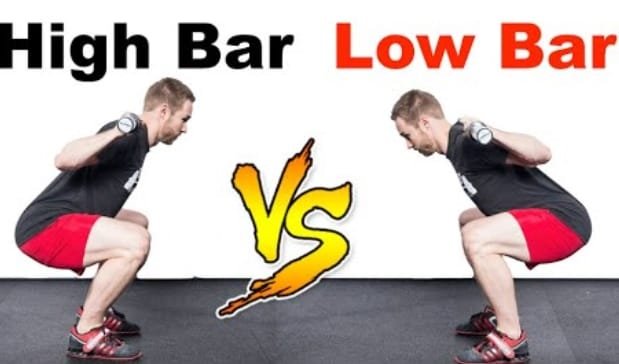
by admin | May 30, 2022 | Workouts
Squat 101 | Part 2 – High Bar vs Low Bar
The Back Squat is a fundamental movement for building strength in our legs. It is one of the most difficult exercises out there because it requires physical and mental effort to get under the bar. The form of the Back Squat is hard to master and this is probably the reason why we see so many scared trainees that think squatting is bad for their backs.
Remember that ugly form is what is bad for your back. Performing a perfect deep squat to the ground with your core tight can only benefit your posture and make you stronger. Today, we are investigating further into everything you should know about the two variations of the Back Squat.
What is the difference between High and Low Bar Squat?

While the two types of squat may look almost identical to a novice, there is a big difference between them.
The primary one is in the position of the torso. While doing the High Bar Squat, the bar is placed on our upper trapezius and the torso is more vertical to the ground. With the Low Bar Squat the bar is placed around our back shoulders (deltoids) and the torso is more horizontal to the ground.
This means two things when we perform a High Bar Squat:
- There is less work for our erectors (lower back muscles)
- There is more work for the opposite of the erectors – our abdominal muscles
On top of that, while doing High Bar Squat, the angle in the knees is smaller, compared to the Low Bar Squat. (if we squat deep) For this reason, the knees go forward and the pressure in the lower back is decreased. With that being said, High Bar Squat uses more of our quadriceps, core, and upper back, while the Low Bar Squat puts more pressure on our erectors and hamstrings.
Which one is more efficient?

Efficient is a subjective term. You can build muscle mass in your body with either variation. As you have learned from the previous paragraph, the difference is in the main muscles involved. If your primary goal is to build strength and add as many kilos to the bar as possible, then the Low Bar Squat is the way to go.
The High Bar Squat has a bigger range of motion and puts less pressure on your erectors. If your goal is general hypertrophy and strength, or you are training the Olympic movements, then the High Bar Squat might be the best option for you. One of the “cons” of the High Bar Squat is that you squat less, compared to the Low Bar Squat.
To make it easier for you:
- Low Bar – Strength (1) and Hypertrophy (2)
- High Bar – Hypertrophy (1) and Strength (2)
With “1” being the primary target and “2” being the secondary target without excluding the first. You may already have learned this but let’s explain…
Which One Is Safer?
At the beginning of this article, we mentioned that a perfectly performed squat can only benefit you. In general, the Low Bar Squat puts more pressure on our lower back and this may be a reason someone can mark it as “unsafe”. The High Bar Squat is our go-to variation if you want to progress significantly fast and put less stress on your erectors.
Take-Home Message
Both High Bar and Low Bar Squat can be implemented in your training program. They can both be used as primary leg movements and also as assisting ones. Use them wisely, according to your goals. Thank you for reading this article and now, get under the bar!

by admin | May 30, 2022 | Mind
Start From Yourself
In today’s high-performing, dynamic society, more and more people tend to have higher goals about their personal and career development. This leads people to look for ways in which they can realize those visions and thus, the search for those in the external world becomes a constant. However, one of the most important things to realize, is that this all actually starts from… You.
The Brain

As humans, we are lucky enough to have what appears to be the most complex brain in the known universe. This is an organ, that through the senses, helps you assemble a logical picture of the world. In essence, the brain works on a couple of brainwave frequencies, that change throughout the day and are responsible for certain states of mind.
Those brainwave frequencies are namely – Beta, Alpha, Theta & Delta
Beta is your normal wake state, where you’re completely aware of the environment. These frequencies are further divided into low, medium and high beta frequencies, that scale depending on the amount of stress. Think of low and medium beta as the slight stress you get during various social situations and then, think of high beta frequencies as full-on stress (i.e a dog attacks you on the street).
Alpha on the other hand is a more relaxed state, where a part of your attention goes towards your inner world. This is a state where you can develop ideas, thoughts, visions and connect seemingly unrelated things. Think of alpha as your creative, day-dreaming state of mind.
Theta is an even deeper state of relaxation, where most of your attention goes to your inner world. Think of this as a deep meditative state, that is on the verge between a conscious and an unconscious state.
Finally, delta is a state of deep sleep, where you are not really conscious. These brainwave frequencies are basically your deepest state of recovery, when your brain integrates sensory information and recovers the body. The cycle of these 4 states is synchronized with the day-night cycle of the Earth – As you drift off to sleep, your brain waves slow down to alpha, theta and finally delta when you’re deep asleep.
Oppositely, once sunlight hits your eyes, that is a signal for the brain that it’s time to wake up and thus, the frequencies go up the ladder through theta, alpha and then beta.
Why Is This Important?
If you’ve ever tried to change something about yourself, you probably know that it is a hard task to do so. And the truth is, well, it is hard because you don’t have the right method and timing to do it. You have to understand that you need to be in a certain state of mind to induce changes to otherwise deeply programmed emotions, reactions and behaviors.
Hint: That state of mind is reached at alpha & theta frequencies
Observe The Bad

Luckily enough, we are humans that have conscious control over our bodies, meaning that changes in behavior and emotions can be induced. In order for this to be done, there needs to be a level of self-recognition, where you become aware of any bad parts in your character and environment.
Think of it this way – If something is putting you down physically, emotionally or spiritually, get rid of it! Because if you don’t, those things will affect your life in most of its aspects. You have to essentially catch yourself in the moment when that bad trait/habit/reaction/thought/emotion is emerging and just acknowledge it.
Later on, you can reflect upon those acknowledgements and affirm to yourself that you are making a change to this.
Conclusion
In understanding your brain, its patterns and modes of work, you can easily induce massive changes that will impact your ability to realize any goal or vision in your mind. This will ultimately create a boost for your own personal development and will allow you to have a seamless, enjoyable path in life.
All you have to do is remember that it all starts from your brain.
It all starts from you!
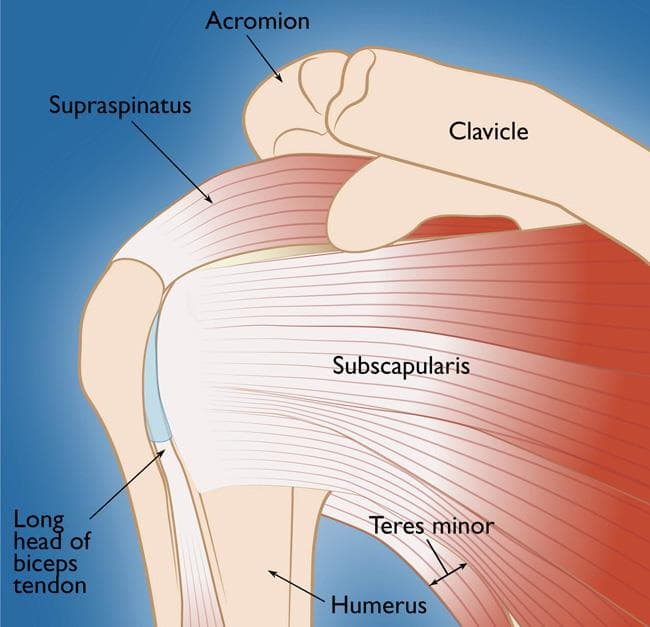
by admin | May 30, 2022 | Health
Shoulder Injuries & The Rotator Cuff | Part 1 – Anatomy & Common Injuries
When it comes to athletic performance, the shoulder is pretty much the most utilized part of the upper body. Practically, every exercise that targets a specific upper body muscle group, requires some kind of movement in the shoulder joint. Now, here is something important right away – The shoulder joint has the biggest range of motion out of all joints in the body.
However, that big range of motion comes at the price of joint stability, making the shoulder one of the most vulnerable joints in the body. Shoulder injuries are common and without a doubt the worst type of injuries. This is due to the fact that they basically force you to completely stop upper body training for some time.
In this series of articles, we are going to look into the shoulder, its anatomy, functions, and exercises to help you strengthen it and prevent injuries. Of course, the superficial deltoid muscles are just one part of the shoulder, beneath which we can find the more important, stabilizing muscle groups.
Without further ado, let’s have a look at the shoulder, in-depth.
Shoulder Muscles Anatomy

The shoulder joint is a ball & socket joint, located between the humerus (upper arm bone) and the scapula. The main muscles of the shoulder joint are: The deltoids (Front, side & rear)
- Supraspinatus
- Infraspinatus
- Teres Minor
- Teres Major
Now, though most of us focus mainly on the deltoids with overhead pressing movements & lateral raises, the last 4 muscles on the list above are often neglected. These 4 little muscles make up what we refer to as the “Rotator cuff”.
The rotator cuff is what actually stabilizes the shoulder joint and if well-developed makes it far less likely for a shoulder injury to occur. Besides serving as a good injury prevention tool, a healthy rotator cuff will also make you stronger on every other upper body movement. This is especially valid for pushing movements, where the arms are unstable under bigger loads.
Functions of the shoulder
Each of the shoulder joint muscles is responsible for certain movements, so let us briefly explain those.

The Deltoids
The superficial muscles of the shoulder are the deltoids, which surround the shoulder joint from all sides. This is why the deltoids are further separated into 3 zones:
- Anterior (front) deltoids
- Medial (side) deltoids
- Posterior (rear) deltoids
The front deltoid head gives a rounder look from the front and is mainly engaged when you lift your arm up from the front. Next to it is the side deltoid, which can give the shoulder line a wider look and is primarily engaged when you lift your arm laterally (to the side).
Lastly, the rear deltoid gives the shoulders a complete, round look, and is primarily engaged when you do movements that pull the shoulder back. Now, though these are the main functions of the deltoid muscles, none of the 3 are ever completely isolated from one another. These muscles always work in synergy but depending on the exercise, one of the 3 is emphasized.
The Rotator Cuff
Beneath the deltoids are the deep shoulder muscles, which as we mentioned, serve as stabilizers of the shoulder joint. The supraspinatus goes from the upper portion of the shoulder blade and attaches to the head of the humerus. Functionally, the supraspinatus absorbs some of the tension that falls on the shoulder joint and more importantly, keeps the head of the humerus firmly pressed in the shoulder socket.
The infraspinatus is one of the bigger rotator cuff muscles, as it covers most of the shoulder blade and again, attaches at the humerus head. In terms of functionality, this is the muscle that is primarily responsible for the external rotation of the shoulder but also stabilizes the shoulder joint at its socket.
Teres Minor is a relatively small muscle of the rotator cuff, which goes from the lower lateral portion of the shoulder blade, to the head of the humerus. The main functions of the teres minor are external rotation and arm adduction (the movement of the arm towards the midline of the body).
Teres Major is one of the thicker rotator cuff muscles, which goes from the lower portion of the shoulder blade and attaches to the front of the humerus head. This muscle is engaged during arm extension, as well as internal rotation of the arm.
Common Shoulder Injuries

Now that you know some basic anatomy of the shoulder joint, let’s talk about the most common sports-related shoulder injuries. The most common injuries of the shoulder are caused by inflammation, strain, or in the worst case, a complete rupture of one or more tendons of the shoulder musculature.
Now, there are a number of reasons why these injuries occur, but it is important to acknowledge this – The shoulder tendons (and tendons in general) have a weak blood supply as opposed to the muscles. This, therefore, leads to a lesser amount of oxygen and nutrients going to those tissues, making them far more susceptible to degeneration as we age. The second most common reason for shoulder injuries is systematic overexertion with exercises that engage the shoulder, as well as a poor exercise form.
Common shoulder injuries include:
This is a displacement of the shoulder from its normal position in the socket. A dislocation is usually the result of an impact/fall or overexertion at an awkward angle.
The frozen shoulder is another common injury, which is usually the result of inflammation of the shoulder socket. A frozen shoulder is usually accompanied by stiffness, pain, and limited range of motion in the shoulder joint.
This type of injury is common in athletes who mainly use the upper body at high levels of exertion and awkward angles (think rock climbing). With resistance training, this type of injury often occurs during high exertion on heavy pressing movements like the bench press and the overhead shoulder press.
It is mainly expressed in shoulder pain, instability, and limited range of motion. Most tears are partial, but in severe cases, a tendon may completely come off the bone.
Bursae are small, lubricating sacs located in joints across the body. In the shoulders, the bursae are located between the rotator cuff & the bone above the shoulder (acromion). Bursitis is essentially a condition that occurs when that lubricating sac gets inflamed and usually results in pain, tenderness, and a decreased range of motion.
Acknowledgments
In the second part of this article series, we are going to tell you more about the means of preventing shoulder injuries, as well as exercises to make the shoulders bigger and stronger.
Here are some important takeaways from this article:
- The shoulder joint is the most mobile joint in the body, but also one of the less stabilized, which makes it susceptible to injury.
- This joint is involved in all upper body movements, which is why training intensity & programming should be carefully managed
- Besides the superficial deltoids, the shoulder has stabilizer deep muscles known as the “rotator cuff”
If you have not yet experienced a shoulder injury, there are preventative measures you can (and should) consider, even if your shoulders are completely healthy. In the second article of this series, we are going to discuss shoulder stabilizing & strengthening exercises, as well as workout tips.
All of these will ultimately help you maintain shoulder health and avoid any type of injuries.
See you in the next article!


















